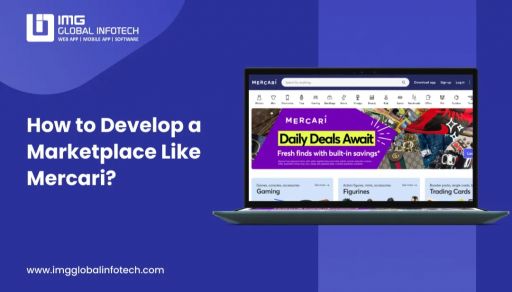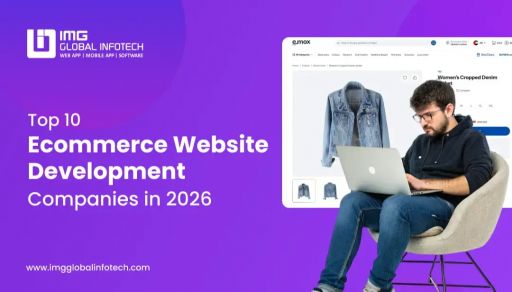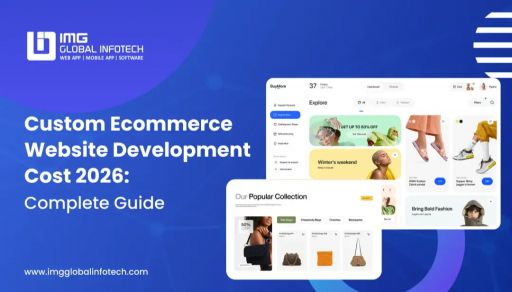How To Build A Ecommerce Website Like Etsy?
Mohit Mittal
Nov 21, 2025

The rise of dedicated ecommerce platforms has opened the doors for entrepreneurs to create successful online marketplaces tailored to specific audiences and Etsy is a perfect example. Known for its focus on handmade, vintage, and craft goods, Etsy has built a loyal platform for independent sellers and buyers who value creativity and authenticity.
If you’ve ever considered building a similar marketplace like Etsy, whether to serve artisans, local makers, digital creators, or a unique niche, now is a great time to do it. With the right strategy, tools, and features, you can launch a marketplace that connects vendors with customers in a meaningful, profitable way.
In this blog, we’ll walk you through everything you need to know about how to create a website like Etsy, from understanding the core business model and must-have features to choosing the right tech stack, estimating ecommerce app development costs, and launching your own successful ecommerce marketplace.
How Websites Like Etsy Works?

Websites like Etsy operate as multi-vendor ecommerce marketplaces, where individual sellers (vendors) can create their own window and list products for sale, while customers browse and purchase items directly through the platform. These platforms act as intermediaries, facilitating the buying and selling process without owning or producing inventory themselves.
Let’s break down how a website like Etsy functions, step-by-step:
1. Seller Registration & Store Creation
Vendors can register on the platform and set up their own mini online store. This includes:
-
Creating a seller profile
-
Uploading product listings with images, descriptions, pricing, and categories
-
Managing inventory, order processing, and shipping preferences
2. Product Discovery for Buyers
Customers visit the website and can:
-
Search for products using keywords, filters, and categories
-
Browse featured items, seller recommendations, or seasonal picks
-
View individual product pages with detailed descriptions, ratings, and reviews
3. Shopping Cart & Checkout
Buyers can add products from multiple sellers to a single shopping cart and complete their purchase in one streamlined checkout process.
Key functions include:
-
Price breakdown (including shipping & taxes)
-
Secure payment options (credit/debit cards, PayPal, Apple Pay, etc.)
-
Order confirmation and email receipts
4. Order Management for Sellers
Once an order is placed:
-
Sellers receive notifications and access to the buyer’s shipping details
-
They can manage order status (processing, shipped, delivered)
-
Some platforms integrate with third-party logistics or shipping calculators
5. Commission & Revenue Model
Marketplace websites like Etsy make money by charging:
-
Listing Fees – A small fee per product listed
-
Transaction Fees – A percentage of each successful sale
-
Subscription Plans – For sellers who want advanced tools or promotional features
-
Ad Revenue – Via promoted listings or internal ads
6. User Reviews and Ratings
To maintain trust and transparency, both buyers and sellers can leave reviews. This builds credibility and helps new customers make informed purchasing decisions.
7. Admin Dashboard & Moderation
The platform’s admin panel allows site owners to:
-
Monitor sales, users, and product activity
-
Handle disputes or flag inappropriate content
-
Manage fees, payouts, and system settings
-
Track marketplace performance through analytics
Must-Have Features for an Etsy-Like Marketplace
To successfully create a marketplace like Etsy, your platform needs to offer an intuitive, engaging, and trustworthy environment for both buyers and sellers. The key lies in replicating Etsy's core functionality while customizing it to fit your niche and business goals.
Here are the must-have features that every Etsy-like website should include:
1. Multi-Vendor Registration & Onboarding
Your platform should allow individual sellers to:
-
Sign up or apply as vendors
-
Create and manage their own storefronts
-
Upload branding elements like logos and banners
-
Add business details, shipping preferences, and payment info
2. Product Listing Management
Sellers need an easy-to-use dashboard to:
-
Add, edit, and organize products
-
Set multiple variants (size, color, materials, etc.)
-
Add product descriptions, SEO tags, pricing, and inventory status
-
Upload multiple high-resolution product images
3. Advanced Search & Filtering
Your marketplace should allow buyers to:
-
Search by keyword, category, price range, ratings, etc.
-
Apply filters for item type, availability, and vendor location
-
See relevant search suggestions and trending tags
4. Shopping Cart & Secure Checkout
A unified cart that allows multi-vendor purchases with:
-
Clear cost breakdown by vendor
-
Discount codes or promo integration
-
Secure payment gateways (Stripe, PayPal, local methods)
-
Order confirmation and transactional emails
5. Vendor Dashboard
Give sellers a powerful backend to manage:
-
Orders and shipping
-
Product inventory
-
Revenue and payout tracking
-
Customer queries and reviews
-
Analytics for performance insights
6. Ratings & Reviews System
Enable both buyers and sellers apps to:
-
Rate and review each other post-transaction
-
Display verified purchase badges
-
Report abusive or fake reviews
7. Admin Dashboard
As the marketplace owner, you’ll need a full admin panel to:
-
Manage sellers, products, and users
-
Monitor performance and activity
-
Moderate content and handle disputes
-
Configure commission rates, taxes, and payout cycles
8. Notifications & Messaging
Integrate features like:
-
Real-time notifications for orders, messages, or reviews
-
In-app messaging between buyers and sellers
-
Email alerts and promotional messages
9. Mobile Responsiveness or Mobile App
Ensure your marketplace is accessible across devices:
-
Mobile-first responsive design
-
Progressive Web App (PWA) or native mobile app
-
Smooth navigation, fast loading, and easy checkout
10. Wishlist & Save for Later
Let buyers:
-
Save favorite items for later
-
Create wishlists or collections
-
Receive alerts for price drops or back-in-stock items
11. Secure Payment & Payout System
Offer:
-
Secure payment processing for customers
-
Automated payouts to sellers (after deducting commission)
-
Support for local and international payment options
12. Blog or Content Hub (Optional but Valuable)
A content section to:
-
Share tips, seller success stories, or featured products
-
Improve SEO and build community engagement
How to Build a Website Like Etsy?

Creating a successful multi-vendor ecommerce website like Etsy involves more than just website development, it’s about crafting an intuitive, secure, and scalable ecosystem for both buyers and sellers. Below is a comprehensive breakdown of each essential step in the web designing process:
1. Define Your Niche and Business Model
Before you begin B2C ecommerce website development, it’s important to clearly define the niche your platform will serve. Etsy thrives by focusing on handmade, vintage, and craft-related goods. Similarly, your marketplace should target a specific audience or product category that fills a gap in the market. Decide on how the platform will make money, whether it’s through listing fees, sales commissions, premium subscriptions, or in-app advertising. Having a solid business model and value proposition will guide your design, development, and marketing strategies.
2. Conduct Market Research
Thorough market research is essential to validate your idea and shape your platform's features. Study best online shopping apps like Etsy, Amazon Handmade, and niche-specific platforms to understand what they offer and what users expect. Look for pain points in existing platforms and identify opportunities to offer something better. Research user preferences, trending product categories, and seller challenges. This data-driven approach ensures your platform solves real problems and stands out in a crowded marketplace.
3. Choose the Right Development Approach
Next, determine how you want to build your site. You can opt for custom development from scratch, which offers full flexibility but comes with higher costs. Alternatively, you can use marketplace-building platforms like Sharetribe, Arcadier, or Magento Marketplace for a quicker and more cost-effective launch. If you’re on a tight budget, a CMS-based solution using WordPress with plugins like WooCommerce and Dokan can be a good starting point. The right choice depends on your budget, timeline, scalability needs, and technical resources.
4. Hire the Right Development Team
Once you’ve finalized the development approach, it’s time to assemble your team. At a minimum, you’ll need a UI/UX designer, front-end and back-end developers, and a QA tester. If managing the project yourself is overwhelming, hiring a project manager or partnering with an experienced ecommerce development agency can make things smoother. A skilled team ensures your marketplace is not only functional but also scalable, secure, and user-friendly.
5. Design the User Interface (UI/UX)
A seamless user experience is a core reason behind Etsy’s success. Invest in intuitive and attractive design layouts for essential pages such as the homepage, product listings, seller profiles, and checkout. Focus on easy navigation, consistent branding, and mobile responsiveness. Incorporate features like quick product previews, smart filters, and clear CTAs. A well-designed UI/UX builds trust, encourages exploration, and increases conversion rates especially among mobile shoppers. Considering the reasons for website redesign helps ensure your marketplace stays modern, improves usability, and continues to drive higher engagement and conversions.
6. Develop Core Marketplace Features
Your dedicated development team for hire should focus on building all core functionalities necessary for a marketplace to operate. This includes multi-vendor registration, product listing management, shopping cart, secure checkout, order tracking, review systems, and an admin panel. Make sure vendors can manage their own stores independently, while buyers enjoy a smooth and secure shopping experience. Start with an MVP (Minimum Viable Product) that includes essential features and expand it based on user feedback.
7. Integrate Payment and Payout Systems
A critical part of any ecommerce site is a secure and user-friendly payment system. Integrate popular gateways like PayPal, Stripe, or Razorpay to handle customer payments smoothly. Additionally, set up an automated system to distribute payments to sellers after deducting platform commissions. Ensure compliance with local tax regulations, and implement secure, transparent tracking of transactions for both buyers and sellers to maintain trust.
8. Test Thoroughly Before Launch
Before going live, run comprehensive testing across all parts of the website. This includes functional testing to ensure features work as expected, usability testing to verify the interface is intuitive, and performance testing to ensure the site handles load efficiently. Also, test the mobile experience, payment flow, notifications, and third-party integrations. Fix bugs, polish design elements, and double-check content to ensure a smooth experience from day one.
9. Launch the Platform
With all systems tested, you’re ready to launch. Start with a soft launch or beta version with limited users, this allows you to collect feedback and make quick improvements. Prepare pre-launch marketing materials, build hype through social media, email lists, or influencers, and make sure your customer support team is ready. Guide your first batch of sellers with onboarding tutorials or live support to ensure early success and positive word-of-mouth.
10. Monitor, Improve & Scale
Your work doesn’t end at launch. Continuously monitor user behavior through analytics tools, gather feedback, and improve features based on real-world use. Enhance SEO, page loading speed, and product discovery tools to boost visibility. Scale your infrastructure as your user base grows, and consider launching mobile apps for better accessibility. Over time, you can introduce premium features, loyalty programs, or AI-based personalization to stay competitive and keep users engaged.
>>>Also Read: How to Start an Ecommerce Business in India?
How Much Does It Cost to Create a Website Like Etsy?
Building a multi-vendor ecommerce website like Etsy involves many variables such as design complexity, features, technology stack, and the cost of hiring remote software developers. Estimated cost to build an Etsy like website can range between $15,000 to $50,000+. Whether you're a startup or an established business, understanding the Etsy like ecommerce app development cost structure will help you set a realistic budget and avoid unexpected expenses.
Here’s a complete ecommerce website development cost breakdown of what you can expect to spend in 2026:
Why Choose IMG Global Infotech For Etsy Like Ecommerce Website Development?
Choosing IMG Global Infotech for your Etsy-like website development means partnering with a team that specializes in building scalable, secure, and user-centric multi-vendor marketplaces. With deep expertise in B2B ecommerce development, we craft fully customized solutions tailored to your business model, whether you're targeting handmade goods, digital products, or niche categories. Our team leverages a modern tech stack, including Laravel, React, Node.js, and Flutter to deliver high-performance platforms with scalable architecture. From intuitive UI/UX design and robust vendor dashboards to payment gateway integration and post-launch maintenance, we offer complete end-to-end development services. Based in India, IMG Global Infotech provides international-quality development at cost-effective prices, making us an ideal partner for startups and growing businesses. With a proven track record and clients across Australia, the USA, UAE, and beyond, we’re committed to building marketplace platforms that are not only functional but also built for long-term growth and success. When you choose us, you choose experience, transparency, and a team dedicated to bringing your ecommerce vision to life.
Conclusion
Creating a website like Etsy is more than replicating a marketplace, it's about creating a vibrant digital ecosystem where creators and customers connect, transact, and thrive. From defining your niche and planning the right features to choosing the right tech stack and dedicated ecommerce developers for hire, each step plays a critical role in your platform’s success.
Whether you’re targeting handmade products, vintage collectibles, or niche ecommerce categories, your marketplace must be scalable, user-friendly, and secure. Partnering with an experienced ecommerce development company like IMG Global Infotech ensures your platform is not just built, but built right. With a focus on customized functionality, seamless UX, and long-term growth, we help turn marketplace ideas into fully functioning, revenue-generating platforms.
Mohit Mittal is the co-founder of a leading IT company with over a decade of experience in driving digital transformation and innovative tech solutions. With a strong background in software development, Mobile app development, E-commerce, business strategy, and team leadership, Mohit Mittal is passionate about helping businesses scale through technology. When not solving complex tech challenges, he enjoys sharing insights on emerging trends, entrepreneurship, and the future of IT.












